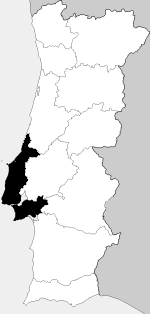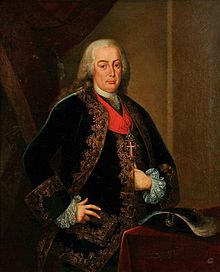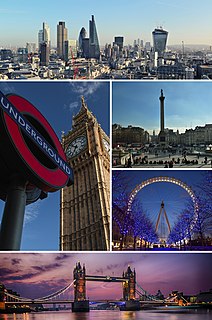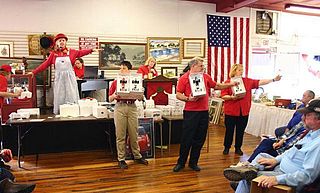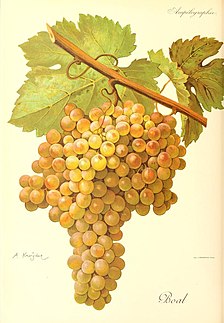
Vinho Verde refers to Portuguese wine that originated in the historic Minho province in the far north of the country. The modern-day 'Vinho Verde' region, originally designated in 1908, includes the old Minho province plus adjacent areas to the south. In 1976, the old province was dissolved.

Douro is a Portuguese wine region centered on the Douro River in the Trás-os-Montes e Alto Douro region. It is sometimes referred to as the Alto Douro, as it is located some distance upstream from Porto, sheltered by mountain ranges from coastal influence. The region has Portugal's highest wine classification as a Denominação de Origem Controlada (DOC). While the region is associated primarily with Port wine production, the Douro produces just as much table wine as it does fortified wine. The non-fortified wines are typically referred to as "Douro wines".
Bairrada is a Portuguese wine region located in the Beira Litoral Province. The region has Portugal's highest wine classification as a Denominação de Origem Controlada (DOC). It is located close to the Atlantic which ocean currents have a moderating effect on the climate. The region is bordered to the north by the Lafões IPR and to the east by the Dão DOC. The region is known for its deep colored tannic red wines that often have bell pepper and black currant flavors as well its emerging rosé production. The boundaries of the Bairrada DOC includes the municipalities of Anadia, Cantanhede, Mealhada and Oliveira do Bairro.
The denominação de origem controlada is the system of protected designation of origin for wines, cheeses, butters, and other agricultural products from Portugal.
Alcobaça is a Portuguese wine region centered on the town of Alcobaça in the Estremadura region. The region was initially an Indicação de Proveniencia Regulamentada (IPR) region, but in 2005 it became one of two subregions of the Encostas d'Aire DOC, which has Denominação de Origem Controlada (DOC) status. Its name may still be indicated together with that of Encostas d'Aire, as Encostas d'Aire-Alcobaça.
Arruda is a Portuguese wine region centered on the town of Arruda dos Vinhos in the Lisboa wine region. The region is designated as Denominação de Origem Controlada (DOC) after it was promoted from its former Indicação de Proveniencia Regulamentada (IPR) status. The region is known primarily for its red wine production.

Chaves is a Portuguese wine region centered on the town of Chaves in the Trás-os-Montes e Alto Douro region. The region was initially a separate Indicação de Proveniencia Regulamentada (IPR) region, but in 2006, it became one of three subregions of the Trás-os-Montes DOC, which has the higher Denominação de Origem Controlada (DOC) status. Its name may still be indicated together with that of Trás-os-Montes, as Trás-os-Montes-Chaves.
Lafões is a Portuguese wine region, near Viseu, overlapping into the Dão and Vinho Verde DOCs. The region has the second tier Indicação de Proveniencia Regulamentada (IPR) classification and may some day be promoted to Denominação de Origem Controlada (DOC). The region is known for its acidic, light bodied, red and white wines.

Bucelas is a Portuguese wine-region located in the Lisboa wine-region. The region has Portugal's highest wine classification as a Denominação de Origem Controlada (DOC). Located south of the Arruda DOC, the region is noted for its potential for cool fermentation white wine production. Vineyards in the area are planted on predominantly loam soils. The white wines of Bucelas became widely popular during the Elizabethan era in England and again during the Victorian age. In London the wines were sometimes described as Portuguese hock because of their similarities to the German Rieslings from the Rhine. Urban sprawl in the 20th century has drastically reduced viticulture in the area, located north of the Portuguese capital city, Lisbon.
Colares is a Portuguese wine region centered on the Colares municipality in Estremadura region. The region has Portugal's highest wine classification as a Denominação de Origem Controlada (DOC). Located along the southwestern Atlantic coast, vineyards in the area are protected from the strong ocean winds by sandy dunes. In 1940s, vineyards covered 2,500 acres but have since been reduced by suburbanization to 50 acres. Between 1934 and 1994, only the local co-op could use the Colares appellation. Because grapevines there are grown directly upon the sand, and phylloxera aphids cannot live on sand, Colares vineyards are some of the only European vines that are not grafted upon American rootstocks. The ungrafted Ramisco vines of the Colares region are some of the oldest in Portugal. The region is known for its deep colored, full bodied red wines that are high in astringent tannins.
Lagoa is a Portuguese wine region centered on the Lagoa municipality in the Algarve region. The region has Portugal's highest wine classification as a Denominação de Origem Controlada (DOC). The region is bordered to the west by the Portimão DOC and to the east by Tavira DOC. The region has been historically known for its fortified wine production but has been expanding its table wine production in recent years.

Minho, formerly Rios do Minho, is a Portuguese wine region covering the same areas as the Vinho Verde DOC. The region is classified as a Vinho Regional (VR), a designation similar to a French vin de pays region. The wines of the Minho and Vinho Verde are nearly identical except for the Minho VR allowing foreign grape varieties to be used that are excluded from the Denominação de Origem Controlada (DOC) regulations for Vinho Verde.
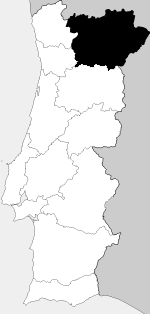
Trás-os-Montes is a Portuguese wine region located in the Trás-os-Montes e Alto Douro region. The entire wine region is entitled to use the Vinho Regional designation Transmontano VR, while some areas are also classified at the higher Denominação de Origem Controlada (DOC) level under the designation Trás-os-Montes DOC. VR is similar to the French vin de pays and DOC to the French AOC.
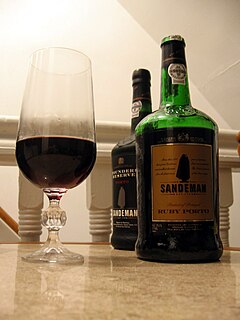
The history of Portuguese wine has been influenced by Portugal's relative isolationism in the world's wine market, with the one notable exception of its relationship with the British. Wine has been made in Portugal since at least 2000 BC when the Tartessians planted vines in the Sado and Tagus valleys. By the 10th century BC, the Phoenicians had arrived and introduced new grape varieties and winemaking techniques to the area. Up until this point, viticulture was mostly centered on the southern coastal areas of Portugal. In later centuries, the Ancient Greeks, Celts and Romans would do much to spread viticulture and winemaking further north.

The Douro Wine Company was a government oversight organization established by the Portuguese Prime Minister Sebastião José de Carvalho e Melo, Marquis of Pombal to regulate the trade and production of Port wine. Established in 1756, one of the first official duties of the company was the delineation of the boundaries of the Douro wine region. This act essentially made the Douro the world's first regional appellation. While the boundaries of the Chianti and Tokaji wine regions were outlined in 1716 and 1737, respectively, neither of these regions were "technically" appellations in the sense of being subjected to continued government control and regulations. Under their charter, Pombal invested an immense amount of control in the Douro Wine Company to regulate all exports of Port, set production quantities limits, fix maximum and minimum prices for grapes and to serve as sole arbitrator in any disputes between vine growers and Port shippers. In 1761, the company was further granted a monopoly on the sale of brandy which was used in the fortification process of Port winemaking. The Douro Wine Company continued to operate to 1833. Today, many of it functions have been deregulated with the Instituto dos Vinhos do Douro e do Porto or being the official regulating body of Port wine and Douro table wine production.
Rabo de Ovelha is white Portuguese wine grape variety that is grown all over Portugal. It should not be confused with the red Rabo de Anho grape variety that is found in the Vinho Verde region. Rabo de Ovelha is an authorized grape variety in the Bairrada, Borba, Bucelas, Redondo, Reguengos, Setúbal and Vidigueira Denominação de Origem Controlada (DOC). The grape variety gets its name from the way its grape bunches resembles the end of a ewe's tail. In winemaking, Rabo de Ovelha is known for producing highly alcoholic wines that wine expert Jancis Robinson describes as lacking subtlety.

Vital is a white Portuguese wine grape variety that is grown primarily in Western Portugal. Sometimes known under the synonym Malvasia Corado, the variety tends to produce rather neutral flavor wine with low acidity unless the grape is grown in vineyards of high altitude.
Donzelinho branco is a white Portuguese wine grape variety that is classified as one of the "Very Good" varieties authorized to be used in Port wine production. While rarely seen as a varietal wine, Donzelinho branco is a permitted variety in the white blends of several northern Portuguese wine regions including the Denominação de Origem Controlada (DOC) of Douro and Trás-os-Montes and the Vinho Regional (VR) wines of Duriense and Transmontano.


